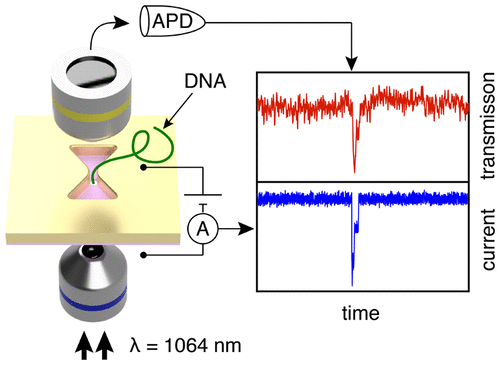Our official English website, www.x-mol.net, welcomes your
feedback! (Note: you will need to create a separate account there.)
Label-Free Optical Detection of DNA Translocations through Plasmonic Nanopores.
ACS Nano ( IF 15.8 ) Pub Date : 2018-12-10 , DOI: 10.1021/acsnano.8b06758 Daniel V Verschueren 1 , Sergii Pud 1 , Xin Shi 1, 2 , Lorenzo De Angelis 3 , L Kuipers 3 , Cees Dekker 1
ACS Nano ( IF 15.8 ) Pub Date : 2018-12-10 , DOI: 10.1021/acsnano.8b06758 Daniel V Verschueren 1 , Sergii Pud 1 , Xin Shi 1, 2 , Lorenzo De Angelis 3 , L Kuipers 3 , Cees Dekker 1
Affiliation

|
Solid-state nanopores are single-molecule sensors that hold great potential for rapid protein and nucleic-acid analysis. Despite their many opportunities, the conventional ionic current detection scheme that is at the heart of the sensor suffers inherent limitations. This scheme intrinsically couples signal strength to the driving voltage, requires the use of high-concentration electrolytes, suffers from capacitive noise, and impairs high-density sensor integration. Here, we propose a fundamentally different detection scheme based on the enhanced light transmission through a plasmonic nanopore. We demonstrate that translocations of single DNA molecules can be optically detected, without the need of any labeling, in the transmitted light intensity through an inverted-bowtie plasmonic nanopore. Characterization and the cross-correlation of the optical signals with their electrical counterparts verify the plasmonic basis of the optical signal. We demonstrate DNA translocation event detection in a regime of driving voltages and buffer conditions where traditional ionic current sensing fails. This label-free optical detection scheme offers opportunities to probe native DNA-protein interactions at physiological conditions.
中文翻译:

通过等离子纳米孔的DNA易位的无标记光学检测。
固态纳米孔是单分子传感器,具有快速蛋白质和核酸分析的巨大潜力。尽管有很多机会,但作为传感器核心的常规离子电流检测方案仍存在固有的局限性。该方案本质上将信号强度与驱动电压耦合,需要使用高浓度电解质,遭受电容性噪声的损害,并损害了高密度传感器的集成度。在这里,我们基于通过等离子体纳米孔的增强的光透射率提出了根本不同的检测方案。我们证明,单个DNA分子的易位可以通过反向领结型等离子纳米孔在传输的光强度中进行光学检测,而无需任何标记。光信号及其电气对应物的表征和互相关验证了光信号的等离子体基础。我们证明了在传统的离子电流检测失败的驱动电压和缓冲条件下,DNA易位事件检测。这种无标记的光学检测方案提供了在生理条件下探查天然DNA-蛋白质相互作用的机会。
更新日期:2018-12-04
中文翻译:

通过等离子纳米孔的DNA易位的无标记光学检测。
固态纳米孔是单分子传感器,具有快速蛋白质和核酸分析的巨大潜力。尽管有很多机会,但作为传感器核心的常规离子电流检测方案仍存在固有的局限性。该方案本质上将信号强度与驱动电压耦合,需要使用高浓度电解质,遭受电容性噪声的损害,并损害了高密度传感器的集成度。在这里,我们基于通过等离子体纳米孔的增强的光透射率提出了根本不同的检测方案。我们证明,单个DNA分子的易位可以通过反向领结型等离子纳米孔在传输的光强度中进行光学检测,而无需任何标记。光信号及其电气对应物的表征和互相关验证了光信号的等离子体基础。我们证明了在传统的离子电流检测失败的驱动电压和缓冲条件下,DNA易位事件检测。这种无标记的光学检测方案提供了在生理条件下探查天然DNA-蛋白质相互作用的机会。











































 京公网安备 11010802027423号
京公网安备 11010802027423号